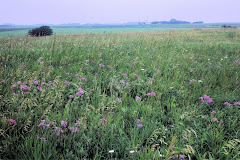The Middle Holocene Period was 5000 to 7000 years in the past. Studies are being done to determine what was happening to global weather at that time. In the US Dr. David Leigh of the University of Georgia is quoted in the March 26, 1999 edition of Science Daily saying that some data leads to the conclusion that the in the the US a region from the Southwest through the Dakotas was likely warm and wet. Much of what is now called Canada was yet covered with an ice sheet in this period. We are beginning to see something of the the circumstances that produced weather in the region of the Jeffers Petroglyph's.
Bryan Fagan in "The Great Warming: Climate Change and the Rise and Fall of Civilizations" (Bloomsbury Press 2008) says that the oceans actually are the weather makers for the earth. Currents that move warm and cool water about produce events such as El Ninos or La Ninas. 800 to 1300 AD was the Medieval Warm Period. That era is recent in time. Civilizations in the Pacific, South America, China, Africa, India, and the Arctic illustrate the dynamic powers of the weather to provide for creation and demise of civilizations.
The principles developed in Dr. Leigh's work can be used to consider possibilities for earlier times. Civilizations grew and waned in rhythm with weather that produced people friendly circumstances and also brought droughts that banished people from regions.
Mid continent North America is insulated from the sea by thousands of miles of land but the weather knows no such boundaries. What is learned about the US Southwest can very likely begin to fill in the blanks as regards weather in mid continent. Ocean currents may well help us to understand better the people who developed the Petroglyphs.
Subscribe to:
Post Comments (Atom)




No comments:
Post a Comment